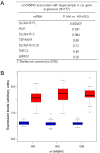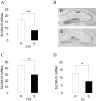The neuronal transporter gene SLC6A15 confers risk to major depression
- PMID: 21521612
- PMCID: PMC3112053
- DOI: 10.1016/j.neuron.2011.04.005
The neuronal transporter gene SLC6A15 confers risk to major depression
Abstract
Major depression (MD) is one of the most prevalent psychiatric disorders and a leading cause of loss in work productivity. A combination of genetic and environmental risk factors probably contributes to MD. We present data from a genome-wide association study revealing a neuron-specific neutral amino acid transporter (SLC6A15) as a susceptibility gene for MD. Risk allele carrier status in humans and chronic stress in mice were associated with a downregulation of the expression of this gene in the hippocampus, a brain region implicated in the pathophysiology of MD. The same polymorphisms also showed associations with alterations in hippocampal volume and neuronal integrity. Thus, decreased SLC6A15 expression, due to genetic or environmental factors, might alter neuronal circuits related to the susceptibility for MD. Our convergent data from human genetics, expression studies, brain imaging, and animal models suggest a pathophysiological mechanism for MD that may be accessible to drug targeting.
Copyright © 2011 Elsevier Inc. All rights reserved.
Figures






Comment in
-
A new, blue gene highlights glutamate and hippocampus in depression.Neuron. 2011 Apr 28;70(2):171-2. doi: 10.1016/j.neuron.2011.04.008. Neuron. 2011. PMID: 21521605
References
-
- Allen Brain Atlas. Seattle (WA): Allen Institute for Brain Science; © 2008 Available from: http://www.brain-map.org.
-
- Alexopoulos GS. The vascular depression hypothesis: 10 years later. Biol Psychiatry. 2006;60:1304–1305. - PubMed
-
- Amunts K, Kedo O, Kindler M, Pieperhoff P, Mohlberg H, Shah NJ, Habel U, Schneider F, Zilles K. Cytoarchitectonic mapping of the human amygdala, hippocampal region and entorhinal cortex: intersubject variability and probability maps. Anatomy And Embryology. 2005;210:343–352. - PubMed
-
- Aulchenko YS, Heutink P, Mackay I, Bertoli-Avella AM, Pullen J, Vaessen N, Rademaker TA, Sandkuijl LA, Cardon L, Oostra B, van Duijn CM. Linkage disequilibrium in young genetically isolated Dutch population. Eur J Hum Genet. 2004;12:527–534. - PubMed
-
- Barrett JC, Fry B, Maller J, Daly MJ. Haploview: analysis and visualization of LD and haplotype maps. Bioinformatics. 2005;21:263–265. - PubMed
Publication types
MeSH terms
Substances
Associated data
- Actions
Grants and funding
LinkOut - more resources
Full Text Sources
Other Literature Sources
Molecular Biology Databases

